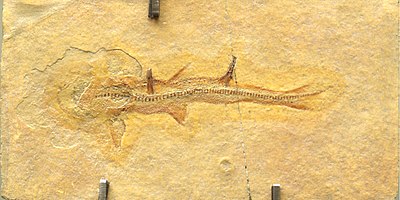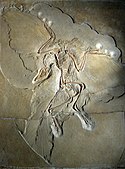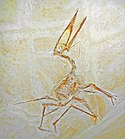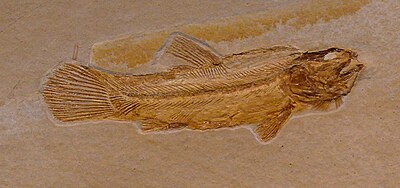Comatula pinnata (fossil crinoid) Solnhofen Limestone
Comatula pinnata Goldfuss, 1831 - fossil stemless crinoid in fine-grained limestone from the Jurassic of Germany. (CM 3852, Carnegie Museum of Natural History, Pittsburgh, Pennsylvania, USA)
This species is also known as Antedon pinnata and (apparently) Pterocoma pinnata.
Crinoids (sea lilies) are sessile, benthic, filter-feeding, stalked echinoderms that are relatively common in the marine fossil record. Crinoids are also a living group, but are relatively uncommon in modern oceans. A crinoid is essentially a starfish-on-a-stick. The stick, or stem, is composed of numerous stacked columnals, like small poker chips. Stems and individual columnals are the most commonly encountered crinoid fossils in the field. Intact, fossilized crinoid heads (crowns, calices, cups) are unusual. Why? Upon death, the crinoid body starts disintegrating very rapidly. The soft tissues holding the skeletal pieces together decay and the skeleton falls apart.
The crinoid shown here is from the famous Solnhofen Limestone, a deposit that includes soft-part preservation. The number one most famous fossil on Earth came from Solnhofen - Archaeopteryx, which is literally half-reptile, half-bird (creationists hate that fossil). The Solnhofen is a lagoon deposit that has marine, nonmarine, and marginal marine organisms, including animals and plants.
Unlike Paleozoic crinoids, this Solnhofen crinoid was stemless/stalkless. Most crinoids in modern oceans similarly lake a stem. Juvenile specimens show evidence of cirri that were used to anchor the individual to substrates. Adult specimens may have been capable of swimming through the water by undulating their arms.
From museum signage:
Fossils from the quarries of Solnhofen in southern Germany reveal the rich variety of life that thrived in and around Late Jurassic seas.
The ancient environmental conditions at Solnhofen resulted in the remarkable preservation of fossils representing hundreds of Late Jurassic plant, invertebrate, fish, reptile, and bird species. A series of shallow, tropical lagoons extended across southern Europe during this time. Reefs and rock outcrops sheltered these waters from the action of waves and tides. When organisms died in these quiet lagoons, they often sank to the bottom to be buried by fine-grained sediments. The water at the bottom of many Solnhofen lagoons contained little or no oxygen. These conditions not only spared many carcasses from damage or decomposition by bacteria and other scavengers, but also helped to preserved delicate soft-tissue features such as skin, scales, and feathers in exquisite detail.
Classification: Animalia, Echinodermata, Crinoidea, Articulata, Comatulida
Stratigraphy: Solnhofen Limestone, Upper Jurassic
Locality: unrecorded/undisclosed site in Bavaria, Germany
See info. at: en.wikipedia.org/wiki/Comatulida and
en.wikipedia.org/wiki/Solnhofen_limestoneRelevante Bilder










































Relevante Artikel
Fossilien der Fränkischen AlbDie Fossilien der Fränkischen Alb sind versteinerte Zeugnisse des vielfältigen Lebens von Fauna und Flora an Land, im Wasser und in der Luft der Fränkischen Alb. Sie fossilierten vom Ende der Trias bis zum Ende des Jura. In diesen erdgeschichtlichen Zeiträumen herrschte ein vorwiegend warmes Klima vor, das die Entwicklung des Lebens begünstigte. .. weiterlesen
